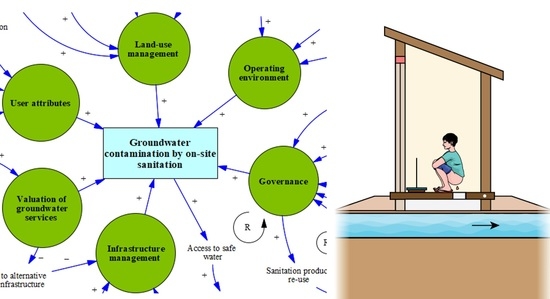Socio-Institutional Drivers of Groundwater Contamination Hazards: The Case of On-Site Sanitation in the Bwaise Informal Settlement, Kampala, Uganda
Abstract
:1. Introduction
2. Analytical Framework
3. Research Design and Methodology
3.1. Study Area
3.2. Groundwater Sample Collection and Water Quality Analysis
3.3. The Transition Arenas and Key Informant Interviews
3.4. Data Analysis
4. Findings
4.1. Groundwater Contamination by On-Site Sanitation in the Bwaise Informal Settlement
4.2. Socio-Institutional Drivers of Groundwater Contamination by OSS in the Bwaise Informal Settlement
“The NWSC only promotes piped water but does not venture much into the groundwater… They are looking at getting profits out of the service (water services), so they are focusing more on the revenue than protection.”
“When it rains, running water (flood water) gathers garbage from a higher altitude and brings it down to lower areas … other people open up their toilets during the rainy season where they allow running water by rain to take all the feces into the groundwater.”
“…one of my kids took (drunk) the water from the spring (not boiled), and that night we had to rush to the hospital with serious diarrhea.”
5. Discussion
6. Conclusions
Supplementary Materials
Author Contributions
Funding
Institutional Review Board Statement
Informed Consent Statement
Data Availability Statement
Acknowledgments
Conflicts of Interest
Appendix A
| Acronym | Description |
|---|---|
| DRASTIC | Depth to groundwater, net recharge to the aquifer, aquifer media, soil media, topography, the impact of the vadose zone, and conductivity of the aquifer |
| GOD | Groundwater occurrence including recharge, overlying lithology, and depth to groundwater |
| HYDRUS | A dual-porosity model for simulating water, heat, and solute movement in the unsaturated zone between the soil surface and the groundwater table |
| IWRM | Integrated water resources management |
| LUGIVE | Land-use management, user attributes, governance, infrastructure management, groundwater valuation (niche), and the operating environment (this paper) |
| MLP | Multi-level perspective |
| MIKE SHE | A physically based, integrated water resources model that simulates both surface and subsurface water dynamics, including interception, evapotranspiration, overland flow, channel flow, unsaturated flow, and saturated zone flow. |
| MODFLOW | Three-Dimension Finite-Difference Groundwater Flow Model (US Geological Survey) |
| OSS | On-site sanitation systems (including pit latrines and septic tanks) |
| SDG | Sustainable Development Goals (United Nations) |
| SINTACS | Depth to groundwater, recharge action, attenuation potential of the vadose zone, attenuation potential of the soil, hydrogeologic characteristics of the aquifer, hydraulic conductivity, and topographic slope. |
| WSP | Water safety plan |
References
- Gleeson, T.; Wada, Y.; Bierkens, M.F.P.; Van Beek, L.P.H. Water balance of global aquifers revealed by groundwater footprint. Nature 2012, 488, 197–200. [Google Scholar] [CrossRef] [PubMed]
- ARGOSS. Guidelines for Assessing the Risk to Groundwater from On-Site Sanitation; ARGOSS: London, UK, 2001. [Google Scholar]
- Lutterodt, G.; Foppen, J.W.; Uhlenbrook, S. Escherichia coli strains harvested from springs in Kampala, Uganda: Cell characterization and transport in saturated porous media. Hydrol. Process. 2014, 28, 1973–1988. [Google Scholar] [CrossRef]
- K’oreje, K.O.; Okoth, M.; Van Langenhove, H.; Demeestere, K. Occurrence and treatment of contaminants of emerging concern in the African aquatic environment: Literature review and a look ahead. J. Environ. Manag. 2020, 254, 109752. [Google Scholar] [CrossRef] [PubMed]
- Lapworth, D.J.; Nkhuwa, D.C.W.; Okotto-Okotto, J.; Pedley, S.; Stuart, M.E.; Tijani, M.N.; Wright, J. Urban groundwater quality in sub-Saharan Africa: Current status and implications for water security and public health. Hydrogeol. J. 2017, 25, 1093–1116. [Google Scholar] [CrossRef] [Green Version]
- United Nations. Transforming Our World: The 2030 Agenda for Sustainable Development; United Nations: New York, NY, USA, 2015; Available online: https://sdgs.un.org/publications/transforming-our-world-2030-agenda-sustainable-development-17981 (accessed on 26 June 2021).
- Adelana, S.M.A. Monitoring groundwater resources in Sub-Saharan Africa: Issues and challenges. In Groundwater and Climate in Africa, Proceedings of the Kampala Conference, Kampala, Uganda, 23–25 June 2008; IAHS Press: Wallingford, UK, 2009; pp. 103–113. [Google Scholar]
- Aboagye, D.; Zume, J.T. Assessing groundwater quality in peri-urban localities of Kumasi, Ghana. Afr. Geogr. Rev. 2019, 38, 390–405. [Google Scholar] [CrossRef]
- Anim-Gyampo, M.; Anornu, G.K.; Agodzo, S.K.; Appiah-Adjei, E.K. Groundwater risk assessment of shallow aquifers within the Atankwidi Basin of Northeastern Ghana. Earth Syst. Environ. 2019, 3, 59–72. [Google Scholar] [CrossRef]
- Nyenje, P.M.; Foppen, J.W.; Kulabako, R.; Muwanga, A.; Uhlenbrook, S. Nutrient pollution in shallow aquifers underlying pit latrines and domestic solid waste dumps in urban informal settlements. J. Environ. Manag. 2013, 122, 15–24. [Google Scholar] [CrossRef]
- Kulabako, N.R.; Nalubega, M.; Thunvik, R. Study of the impact of land use and hydrogeological settings on the shallow groundwater quality in a peri-urban area of Kampala, Uganda. Sci. Total Environ. 2007, 381, 180–199. [Google Scholar] [CrossRef] [PubMed]
- UN-Habitat. Slum Almanac 2015–2016: Tracking Improvement in the Lives of Slum Dwellers; UN-Habitat: Nairobi, Kenya, 2016. [Google Scholar]
- Nixdorf, E.; Sun, Y.; Su, J.; Wang, Q.; Wang, T.; Kolditz, O.; Xi, B. Groundwater risk sources identification and risk reduction management in the Song-Liao-River-Basin. In Chinese Water Systems, Terrestrial Environmental Sciences; Song, Y., Ed.; Springer: Berlin/Heidelberg, Germany, 2018. [Google Scholar] [CrossRef]
- Werz, H.; Hötzl, H. Groundwater risk intensity mapping in semi-arid regions using optical remote sensing data as an additional tool. Hydrogeol. J. 2007, 15, 1031–1049. [Google Scholar] [CrossRef]
- Aller, L.; Bennett, T.; Lehr, J.H.; Petty, R.J.; Hackett, G. DRASTIC: A Standardized System for Evaluating Groundwater Potential Using Hydrogeologic Settings; EPA/600/2-85/018; U.S. Environmental Protection Agency: Washington, DC, USA, 1987. [Google Scholar]
- Boulabeiz, M.; Klebingat, S.; Agaguenia, S. A GIS-based GOD model and hazard index analysis: The quaternary coastal Collo Aquifer (NE-Algeria). Groundwater 2019, 57, 166–176. [Google Scholar] [CrossRef] [PubMed] [Green Version]
- Ouedraogo, I.; Defourny, P.; Vanclooster, M. Mapping the groundwater vulnerability for pollution at the pan African scale. Sci. Total Environ. 2016, 544, 939–953. [Google Scholar] [CrossRef]
- Wang, J.; He, J.; Chen, H. Assessment of groundwater contamination risk using hazard quantification, a modified DRASTIC model and groundwater value, Beijing Plain, China. Sci. Total Environ. 2012, 432, 216–226. [Google Scholar] [CrossRef] [PubMed]
- Barbulescu, A. Assessing groundwater vulnerability: DRASTIC and DRASTIC-Like methods: A review. Water 2020, 12, 1356. [Google Scholar] [CrossRef]
- Saidi, S.; Bouri, S.; Ben Dhia, H.; Anselme, B. Assessment of groundwater risk using intrinsic vulnerability and hazard mapping: Application to Souassi aquifer, Tunisian Sahel. Agric. Water Manag. 2011, 98, 1671–1682. [Google Scholar] [CrossRef]
- Machiwal, D.; Jha, M.K.; Singh, V.P.; Mohan, C. Assessment and mapping of groundwater vulnerability to pollution: Current status and challenges. Earth Sci. Rev. 2018, 185, 901–927. [Google Scholar] [CrossRef]
- Re, V.; Sacchi, E.; Kammoun, S.; Tringali, C.; Trabelsi, R.; Zouari, K.; Daniele, S. Integrated socio-hydrogeological approach to tackle nitrate contamination in groundwater resources. The case of Grombalia Basin (Tunisia). Sci. Total Environ. 2017, 593–594, 664–676. [Google Scholar] [CrossRef] [PubMed]
- Tringali, C.; Re, V.; Siciliano, G.; Chkir, N.; Tuci, C.; Zouari, K. Insights and participatory actions driven by a socio-hydrogeological approach for groundwater management: The Grombalia Basin case study (Tunisia). Hydrogeol. J. 2017, 25, 1241–1255. [Google Scholar] [CrossRef]
- Troy, T.J.; Konar, M.; Srinivasan, V.; Thompson, S. Moving sociohydrology forward: A synthesis across studies. Hydrol. Earth Syst. Sci. 2015, 19, 3667–3679. [Google Scholar] [CrossRef] [Green Version]
- WHO. Water Safety Plans: Managing Drinking-Water Quality from Catchment to Consumer; World Health Organization Press: Geneva, Switzerland, 2015. [Google Scholar]
- Rickert, B.; Schmoll, O.; Rinehold, A.; Barrenberg, E. Water Safety Plan: A Field Guide to Improving Drinking-Water Safety in Small Communities; World Health Organization Press: Geneva, Switzerland, 2014. [Google Scholar]
- Global Water Partnership. Integrated Water Resources Management, Technical Advisory Committee Background Papers (No. 4); Global Water Partnership: Stockholm, Sweden, 2000; Available online: https://www.gwp.org/globalassets/global/toolbox/publications/background-papers/04-integrated-water-resources-management-2000-english.pdf (accessed on 4 August 2021).
- Biswas, A.K. Integrated Water Resources Management: Is it working? Int. J. Water Resour. Dev. 2008, 24, 5–22. [Google Scholar] [CrossRef]
- Foster, S.S.D.; Ait-Kadi, M. Integrated Water Resources Management (IWRM): How does groundwater fit in? Hydrogeol. J. 2012, 20, 415–418. [Google Scholar] [CrossRef]
- Loorbach, D. Transition management for sustainable development: A prescriptive, complexity-based governance framework. Governance 2010, 23, 161–183. [Google Scholar] [CrossRef]
- Rauschmayer, F.; Bauler, T.; Schäpke, N. Towards a thick understanding of sustainability transitions—Linking transition management, capabilities and social practices. Ecol. Econ. 2015, 109, 211–221. [Google Scholar] [CrossRef]
- Roorda, C.; Wittmayer, J.; Henneman, P.; van Steenbergen, F.; Frantzeskaki, N.; Loorbach, D. Transition Management in the Urban Context: Guidance Manual; Dutch Research Institute for Transitions, Erasmus University: Rotterdam, The Netherlands, 2014. [Google Scholar]
- Twinomucunguzi, F.R.B.; Nyenje, P.M.; Kulabako, R.N.; Semiyaga, S.; Foppen, J.W.; Kansiime, F. Reducing groundwater contamination from on-site sanitation in peri-urban Sub-Saharan Africa: Reviewing transition management attributes towards implementation of water safety plans. Sustainability 2020, 12, 4210. [Google Scholar] [CrossRef]
- Silvestri, G.; Wittmayer, J.M.; Schipper, K.; Kulabako, R.; Oduro-Kwarteng, S.; Nyenje, P.M.; Komakech, H.C.; van Raak, R. Transition management for improving the sustainability of WASH services in informal settlements in Sub-Saharan Africa—An exploration. Sustainability 2018, 10, 4052. [Google Scholar] [CrossRef] [Green Version]
- Kabote, J.L.; Mosha, A.K.P.R. Effectiveness of groundwater governance structures and institutions in Tanzania. Appl. Water Sci. 2018, 8, 1–14. [Google Scholar] [CrossRef] [Green Version]
- Daré, W.; Venot, J.P.; Le Page, C.; Aduna, A. Problemshed or watershed? Participatory modeling towards IWRM in North Ghana. Water 2018, 10, 721. [Google Scholar] [CrossRef] [Green Version]
- Pahl-Wostl, C.; Holtz, G.; Kastens, B.; Knieper, C. Analyzing complex water governance regimes: The Management and transition framework. Environ. Sci. Policy 2010, 13, 571–581. [Google Scholar] [CrossRef]
- Geels, F.W. Technological transitions as evolutionary reconfiguration processes: A multi-level perspective and a case-study. Res. Policy 2002, 31, 1257–1274. [Google Scholar] [CrossRef] [Green Version]
- Van Welie, M.J.; Truffer, B.; Gebauer, H. Innovation challenges of utilities in informal settlements: Combining a capabilities and regime perspective. Environ. Innov. Soc. Transit. 2019, 33, 84–101. [Google Scholar] [CrossRef]
- Yin, R.K. The case study as a serious research strategy. Sci. Commun. 1981, 3, 97–114. [Google Scholar] [CrossRef] [Green Version]
- Eisenhardt, K.M.; Graebner, M.E. Theory building from cases: Opportunities and challenges. Acad. Manag. J. 2007, 50, 25–32. [Google Scholar] [CrossRef]
- UBOS. The National Population and Housing Census 2014; Uganda Bureau of Statistics: Kampala, Uganda, 2014. [Google Scholar]
- Geological Survey of Finland (GTK). Geology and Geodynamic Development of Uganda with Explanation of the 1:1,000,000 Scale Geological Map (Special Paper 55); GTK: Espoo, Finland, 2014. [Google Scholar]
- Twinomucunguzi, F.R.B.; Nyenje, P.M.; Kulabako, R.N.; Semiyaga, S.; Foppen, J.W.; Kansiime, F. Emerging organic contaminants in shallow groundwater underlying two contrasting peri-urban areas in Uganda. Environ. Monit. Assess. 2021, 193, 228. [Google Scholar] [CrossRef] [PubMed]
- Van Dijk, M.P. Benchmarking sanitation for the poor has to take the real sanitary problems in the informal settlements of Kampala as the point of departure. Int. J. Water 2016, 10, 175–191. [Google Scholar] [CrossRef]
- Katukiza, A.Y.; Ronteltap, M.; Niwagaba, C.B.; Foppen, J.W.A.; Kansiime, F.; Lens, P.N.L. Sustainable sanitation technology options for urban informal settlements. Biotechnol. Adv. 2012, 30, 964–978. [Google Scholar] [CrossRef]
- WHO. Guidelines for Drinking-Water Quality: Surveillance and Control of Community Supplies, 2nd ed.; World Health Organization Press: Geneva, Switzerland, 1997. [Google Scholar]
- Mushi, D.; Byamukama, D.; Kirschner, A.K.T.; Mach, R.L.; Brunner, K.; Farnleitner, A.H. Sanitary inspection of wells using risk-of-contamination scoring indicates a high predictive ability for bacterial faecal pollution in the peri-urban tropical lowlands of Dar es Salaam, Tanzania. J. Water Health 2012, 10, 236–243. [Google Scholar] [CrossRef] [Green Version]
- Guest, G.; Brunce, A.; Johnson, L. How many interviews are enough?: An experiment with data saturation and variability. Field Methods 2006, 18, 59. [Google Scholar] [CrossRef]
- Braun, V.; Clarke, V. Using thematic analysis in psychology. Qual. Res. Psychol. 2006, 3, 77–101. [Google Scholar] [CrossRef] [Green Version]
- Sousa, D. Validation in qualitative research: General aspects and specificities of the descriptive phenomenological method. Qual. Res. Psychol. 2014, 11, 211–227. [Google Scholar] [CrossRef]
- Kotir, J.H.; Smith, C.; Brown, G.; Marshall, N.; Johnstone, R. A system dynamics simulation model for sustainable water resources management and agricultural development in the Volta River. Sci. Total Environ. 2016, 573, 444–457. [Google Scholar] [CrossRef]
- Sterman, J.D. System dynamics at sixty: The path forward. Syst. Dyn. Rev. 2018, 34, 5–47. [Google Scholar] [CrossRef]
- WHO. Guidelines for Drinking-Water Quality, 4th ed.; World Health Organization Press: Geneva, Switzerland, 2011. [Google Scholar]
- UNBS. Uganda Standard (US EAS 12: 2014): Potable Water—Specification 2014; Uganda National Bureau of Standards (UNBS): Kampala, Uganda, 2014. [Google Scholar]
- Nsubuga, F.W.; Rautenbach, H. Climate change and variability: A review of what is known and ought to be known for Uganda. Int. J. Clim. Chang. Strateg. Manag. 2018, 10, 752–771. [Google Scholar] [CrossRef] [Green Version]
- Omar, Y.Y.; Parker, A.; Smith, J.A.; Pollard, S.J.T. Risk management for drinking water safety in low and middle income countries—Cultural influences on Water Safety Plan (WSP) implementation in urban water utilities. Sci. Total Environ. 2017, 576, 895–906. [Google Scholar] [CrossRef] [PubMed] [Green Version]
- Singh, A.; Srivastav, S.K.; Kumar, S.; Chakrapani, J.G. A modified-DRASTIC model (DRASTICA) for assessment of groundwater vulnerability to pollution in an urbanized environment in Lucknow. India. Environ. Earth Sci. 2015, 74, 5475–5490. [Google Scholar] [CrossRef]
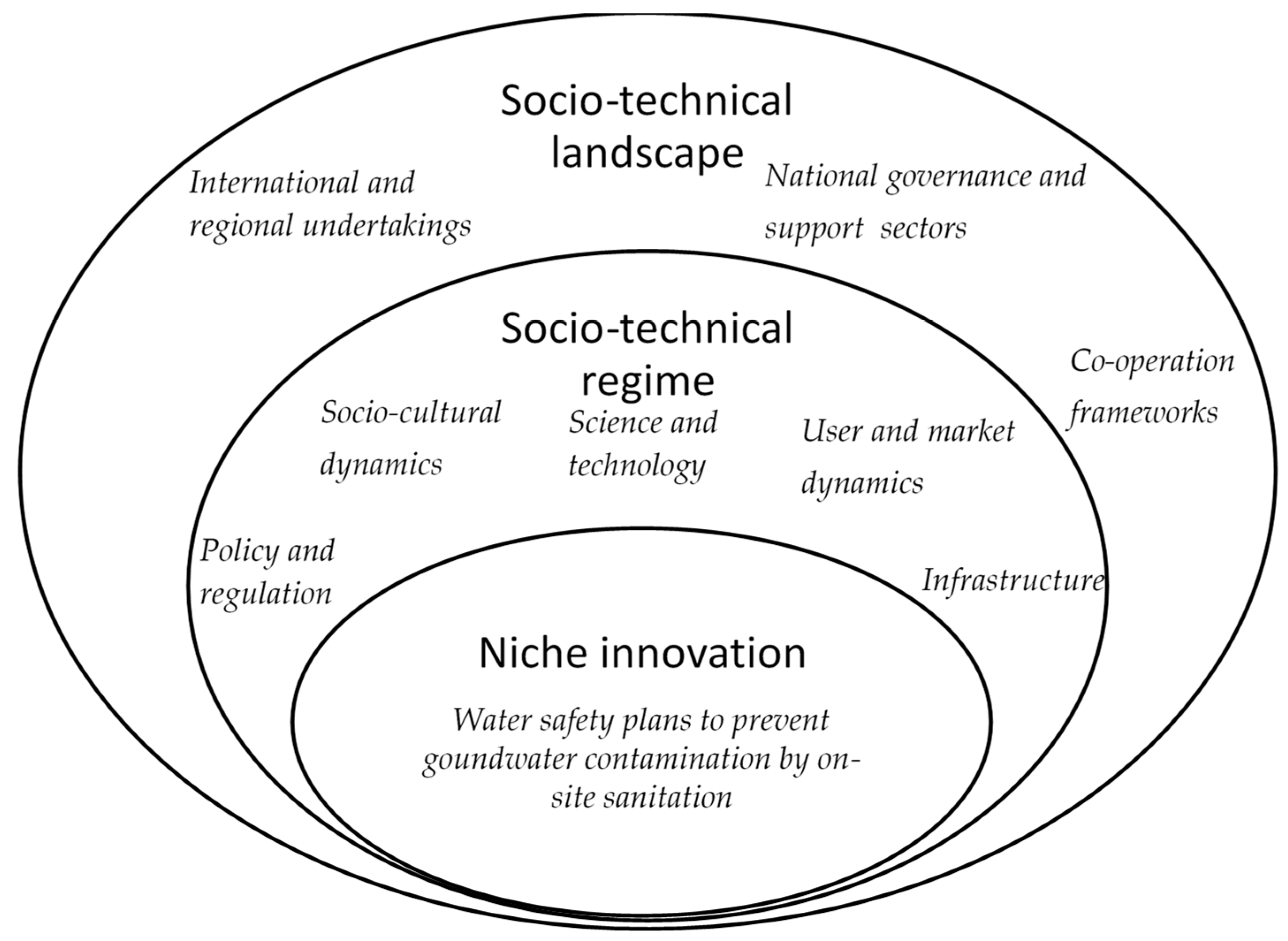
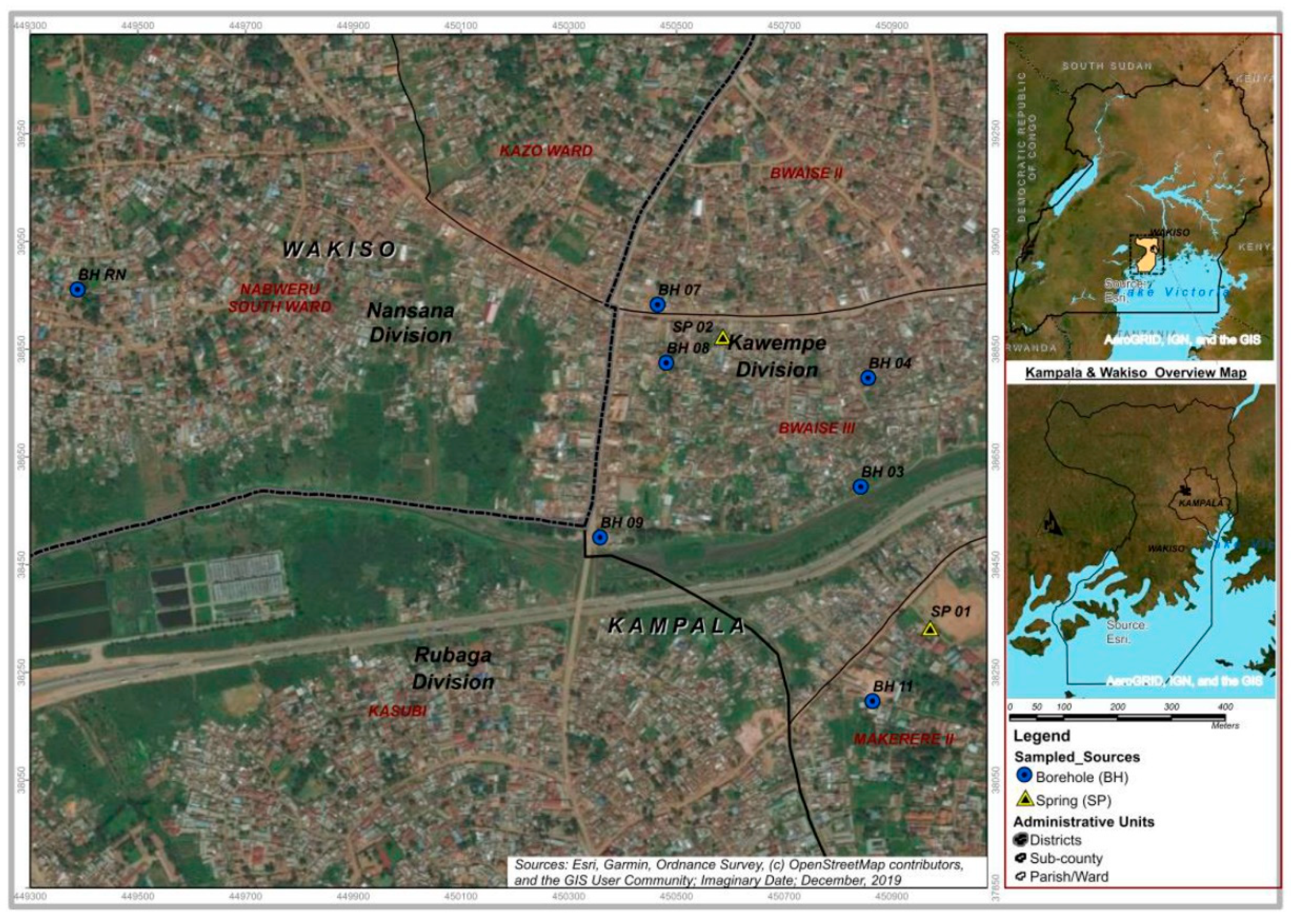
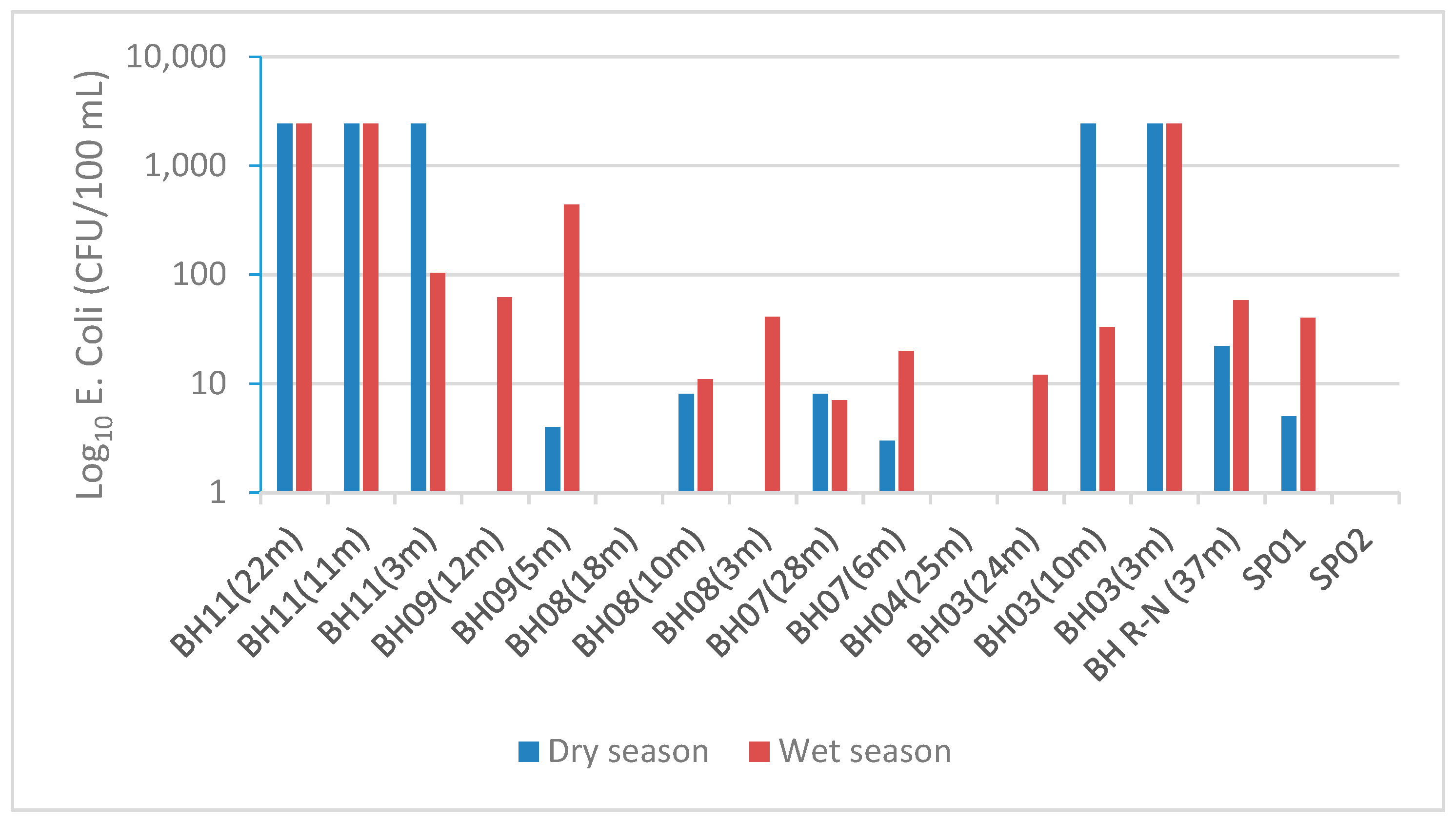
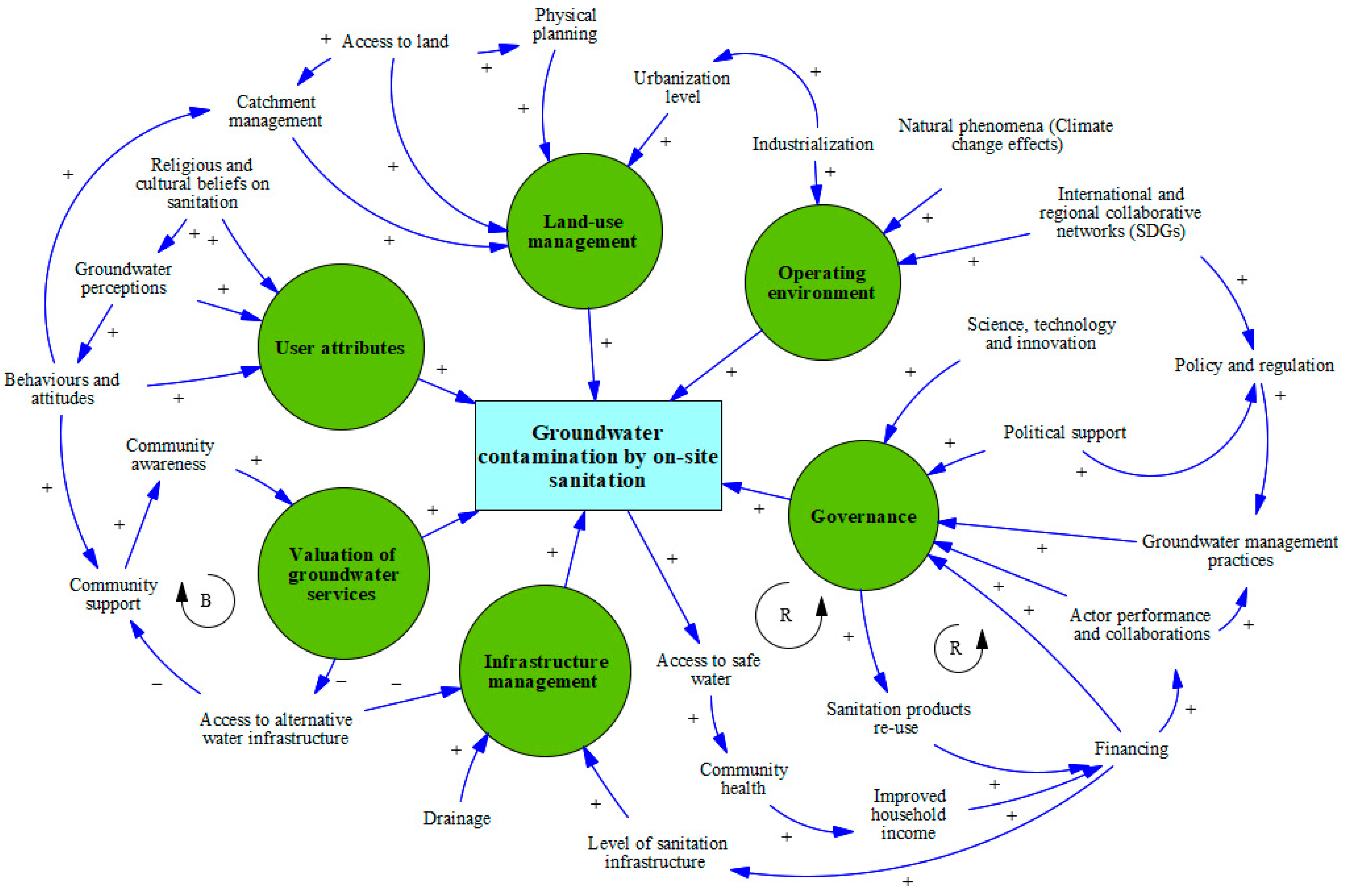
| Participant Descriptors | Number of Respondents |
|---|---|
| Bwaise community members | 2 |
| Water utility (National Water and Sewerage Corporation) | 3 |
| City authority (Kampala Capital City Authority) | 3 |
| Civil society | 5 |
| Development partners | 2 |
| Private sector (Consultants) | 3 |
| Research institutions | 2 |
| National Environmental Management Authority | 3 |
| Ministry of Water and Environment | 8 |
| Ministry of Health | 3 |
| 34 |
| Parameters | Dry Season | Wet Season | WHO Guidelines [54] | Uganda Standards [55] | ||||||
|---|---|---|---|---|---|---|---|---|---|---|
| Min. | Max. | Mean | Stan. Dev. | Min. | Max. | Mean | Stan. Dev. | |||
| Nitrate | 1.0 | 231 | 34 | 60 | 0.1 | 208 | 35 | 59 | 50 | 45 |
| Chloride | 2.3 | 87 | 22 | 21 | 2.5 | 103 | 25 | 27 | - | 250 |
| Ammonia | 0.0 | 3.9 | 0.6 | 1.0 | 0.0 | 2.2 | 0.2 | 0.5 | - | 0.5 |
| Sulphate | 2.1 | 20 | 8.9 | 5.1 | 2.4 | 18 | 8.2 | 4.8 | - | 400 |
| Analytical Level | Socio-Institutional Drivers | Indicators |
|---|---|---|
| Socio-technical regime influences | Land-use management | Access to land for sanitation improvement activities Level of urbanization Level of physical planning Level of catchment protection measures |
| Infrastructure management | Access to improved sanitation infrastructure Cost of improved sanitation infrastructure Access to municipal water infrastructure Level of drainage infrastructure | |
| User attributes | Safe water chain practices Behaviors and attitudes Waste disposal practices Perceptions to groundwater quality Poverty levels (unemployment levels) Influence of religious and cultural beliefs | |
| Governance | Groundwater management practices Attention to common-pool resources Level of sanitation service chain management Effectiveness of policy and regulatory mechanisms Level of financing Political interference in enforcement Actor performance and collaborations Capacity at the community level Weaknesses in decentralization of resources (finances) Policy and regulation limitations Application of science, research, and innovation Competition from the municipal water supply | |
| Socio-technical landscape influences | Operating environment | International and regional collaborative networks Level of industrialization Supportive governance Natural phenomena (climate change effects) |
| Niche influences | Groundwater valuation | Groundwater utilization Community awareness Community support and participation |
Publisher’s Note: MDPI stays neutral with regard to jurisdictional claims in published maps and institutional affiliations. |
© 2021 by the authors. Licensee MDPI, Basel, Switzerland. This article is an open access article distributed under the terms and conditions of the Creative Commons Attribution (CC BY) license (https://creativecommons.org/licenses/by/4.0/).
Share and Cite
Twinomucunguzi, F.R.B.; Silvestri, G.; Kinobe, J.; Mugabi, A.; Isoke, J.; Nyenje, P.M.; Foppen, J.W.; Kulabako, R.N.; Kansiime, F. Socio-Institutional Drivers of Groundwater Contamination Hazards: The Case of On-Site Sanitation in the Bwaise Informal Settlement, Kampala, Uganda. Water 2021, 13, 2153. https://doi.org/10.3390/w13162153
Twinomucunguzi FRB, Silvestri G, Kinobe J, Mugabi A, Isoke J, Nyenje PM, Foppen JW, Kulabako RN, Kansiime F. Socio-Institutional Drivers of Groundwater Contamination Hazards: The Case of On-Site Sanitation in the Bwaise Informal Settlement, Kampala, Uganda. Water. 2021; 13(16):2153. https://doi.org/10.3390/w13162153
Chicago/Turabian StyleTwinomucunguzi, Felix R. B., Giorgia Silvestri, Joel Kinobe, Allan Mugabi, Jenifer Isoke, Philip M. Nyenje, Jan Willem Foppen, Robinah N. Kulabako, and Frank Kansiime. 2021. "Socio-Institutional Drivers of Groundwater Contamination Hazards: The Case of On-Site Sanitation in the Bwaise Informal Settlement, Kampala, Uganda" Water 13, no. 16: 2153. https://doi.org/10.3390/w13162153
APA StyleTwinomucunguzi, F. R. B., Silvestri, G., Kinobe, J., Mugabi, A., Isoke, J., Nyenje, P. M., Foppen, J. W., Kulabako, R. N., & Kansiime, F. (2021). Socio-Institutional Drivers of Groundwater Contamination Hazards: The Case of On-Site Sanitation in the Bwaise Informal Settlement, Kampala, Uganda. Water, 13(16), 2153. https://doi.org/10.3390/w13162153





